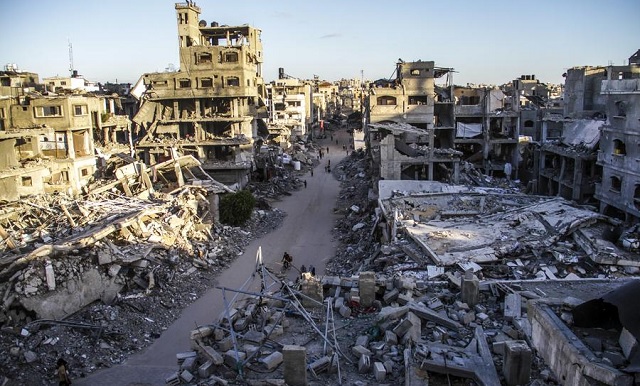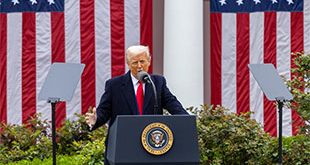
CAIRO,EGYPT | Xinhua | The United States has frequently employed political maneuvers to gain credit for its role in the geopolitical landscape of the Middle East.
In July 2022, prior to a visit to the region, U.S. President Joe Biden proudly asserted in a Washington Post op-ed that “The Middle East I’ll be visiting is more stable and secure than the one my administration inherited 18 months ago,” attributing a more stable Middle East to “a vital leadership role” played by the United States.
In October 2023, just a week before the latest flare-up of conflict between Hamas and Israel, U.S. National Security Adviser Jake Sullivan declared, in an article titled “The Sources of American Power” in Foreign Affairs magazine, that the Middle East “is quieter than it has been for decades.”
However, with claims of credit also comes the burden of responsibility. In the face of the ongoing Gaza conflict, which has surpassed a year and is pushing the Middle East towards the brink of full-scale war, it is crucial to examine the role and responsibilities that the United States holds in the deterioration of this situation.
Analysts argue that the United States has played a significant and irreplaceable role in the continuation and escalation of hostilities. This is evidenced by the repeated use of its veto power in the UN Security Council to block resolutions calling for ceasefires in Gaza. Additionally, the continuous supply of arms to Israel by the United States has further contributed to the intensification of the conflict.
ESCALATING CONFLICT
Throughout the year of the prolonged conflict in Gaza, the United States has consistently expressed its determination to prevent the escalation of the conflict throughout the wider Middle East.
Just four days after the outbreak of hostilities between Hamas and Israel on Oct. 7, 2023, U.S. Secretary of State Antony Blinken embarked on an urgent trip to the Middle East with the stated purpose of “helping prevent the conflict from spreading.”
In the following months, Blinken made nine additional visits to the region. Moreover, the U.S. president, along with other senior officials such as the Secretary of Defense and the CIA Director, has also made frequent visits to the region over the course of the year, all with similar intentions and objectives.
Despite the frequent visits by U.S. officials and their stated determination to contain the conflict, the Gaza conflict persists, with the death toll steadily surpassing that of previous Middle Eastern wars. This underscores a deepening crisis that has become one of the most significant upheavals in the region in recent decades.
The Gaza conflict has by now resulted in the tragic loss of more than 41,800 Palestinian lives, and the number of the injured has reached a staggering 96,000. The United Nations reports that approximately 90 percent of the population, or 1.9 million people, in the Gaza Strip are internally displaced. Disturbingly, many individuals have experienced repeated displacement, with some having been displaced 10 times or even more.
Amidst the enduring suffering faced by the Palestinian population, the flames of discord have also spread across the wider Middle East.
In Lebanon, clashes have occurred between Israeli troops and Hezbollah, adding to the tensions in the region. Additionally, Iran and Israel find themselves trapped in a dangerous cycle of vengeance. Moreover, the Houthis in Yemen, as well as various militant factions in Iraq and Syria, have also become embroiled in the escalating hostilities with Israel.
“As violence intensifies across the Middle East, the region sits on the precipice of a region-wide armed conflict,” the International Committee of the Red Cross has said on X, warning of an imminent humanitarian crisis.
Apparently, the U.S. determination has not effectively curtailed the escalation of the conflict.
The U.S. administration is practicing “lying” when it persistently talks about the possibility for resolving the situation and preventing the conflict from escalating, according to Ashraf al-Ajrami, a Ramallah-based Palestinian expert.
HOLLOW PROMISES
If one were to trust the statements of the U.S. administration, it would seem that a cease-fire agreement between Israel and Hamas would have been imminent by now.
The United States has been actively advocating for a cessation of hostilities in Gaza since May, blatantly claiming that relevant parties are “closer than we’ve ever been” to reaching an agreement.
However, despite the public commitment to mediate a cease-fire, the actions taken by the United States indicate a different story.
Since the outbreak of conflict, the United States has wielded its veto power in the UN Security Council four times, rejecting resolutions related to the Gaza conflict, and turning a deaf ear to the international community’s calls for an immediate ceasefire. On top of this, the United States has been openly supportive of Israel’s military actions against Iran and Lebanon.
Osama Hamdan, a Hamas spokesman, has accused the United States of “merely buying time for Israel to continue its genocide” by making hollow promises about a ceasefire agreement.
To assuage international discontent regarding its perceived collusion with Israel, the United States has not completely ignored the humanitarian catastrophe unfolding in Gaza. Since the conflict began, Washington has funneled hundreds of millions of dollars in humanitarian aid to the region. However, this assistance still pales in comparison to the staggering 8.7 billion dollars in its military aid provided to Israel.
Amidst the relentless barrage of U.S.-manufactured bombs, displaced Palestinians in Gaza are forced to scrape for scarce morsels of bread. The unconditional U.S. support, coupled with Washington’s failure to secure a ceasefire in Gaza, has emboldened Israel to declare an apparent all-out war, and pushed the region to the edge of an abyss, said Elgindy, a senior fellow at the Middle East Institute, a U.S.-based think tank.
SHATTERED U.S. IMAGE
The United States’ disheartening response to the conflict between Hamas and Israel has significantly tarnished its international standing in the Middle East.
A poll conducted earlier this year by the Arab Center Washington D.C. across 16 Middle Eastern countries revealed that 76 percent of respondents now view America’s role in the Arab world more negatively.
The genuine resolution of regional conflicts requires that countries, including Palestine, “enjoy equal rights of statehood, sovereignty and security,” Rami G Khouri, a distinguished fellow at the American University of Beirut, said in an article on the website of Al Jazeera.
“The United States and Israel speak vague words along these lines, but act in ways that prevent serious peace-making and promote eternal military conflicts,” Khouri pointed out.
Khouri was echoed by Juan Cole, a history professor at the University of Michigan, who said that the U.S. administration let the Israeli government “completely disregard international law when it comes to its treatment of the Palestinians.”
“To sum up, the ligaments of American influence in the Middle East are now dissolving before our very eyes,” Cole added in an opinion piece in The Nation magazine.
The New York Times was even more direct in its assessment of Washington’s role in the Gaza conflict, stating bluntly that the U.S. impact on resolving the crisis has been “zero.” The article further criticized Biden’s Middle East policy, stating that “a year after the Oct. 7 terror attacks, Biden’s Middle East policy appears to be a practical and moral failure.”■
 The Independent Uganda: You get the Truth we Pay the Price
The Independent Uganda: You get the Truth we Pay the Price



